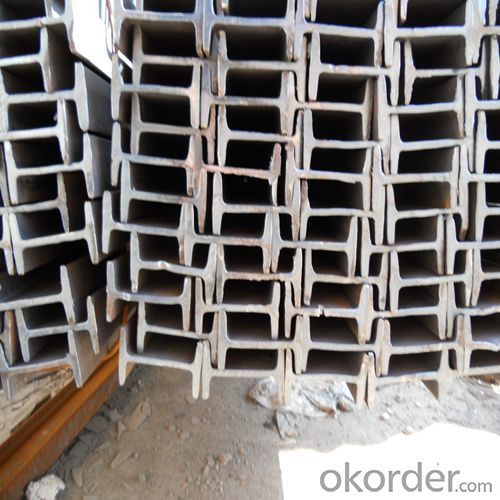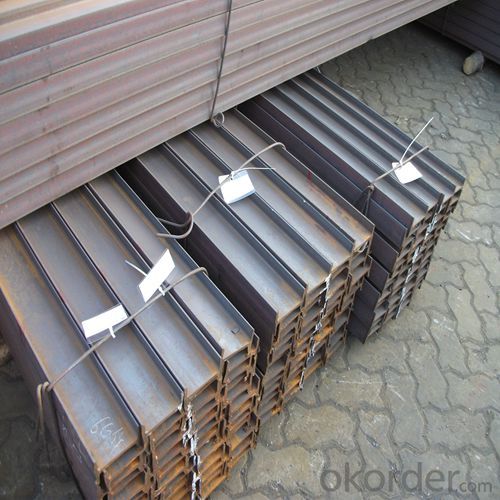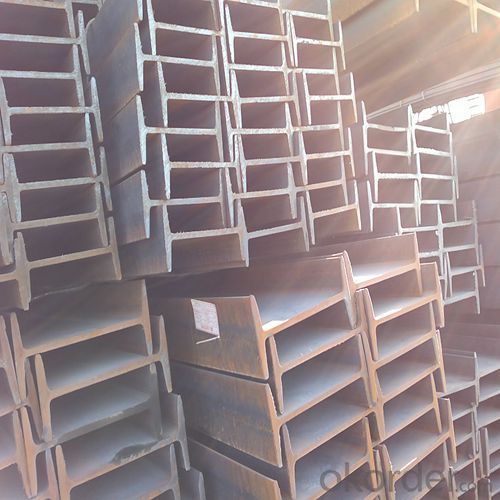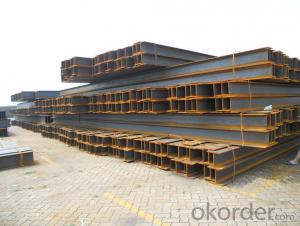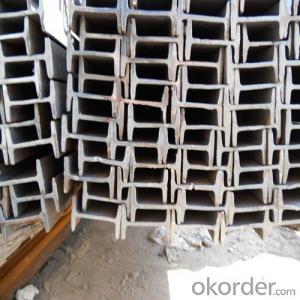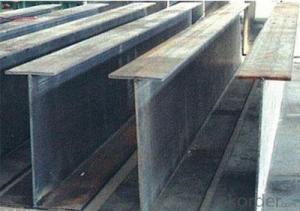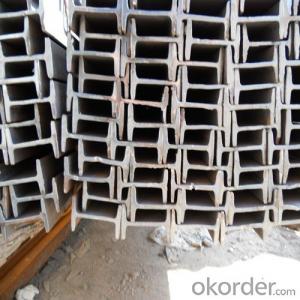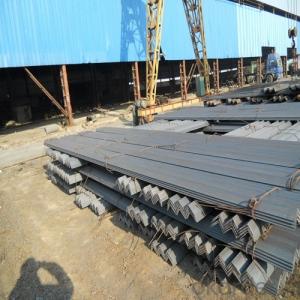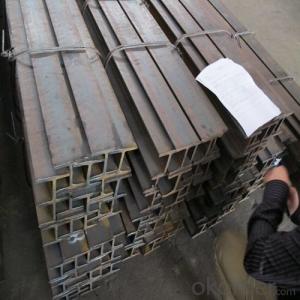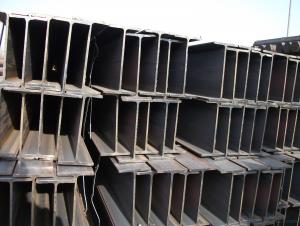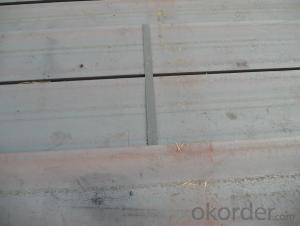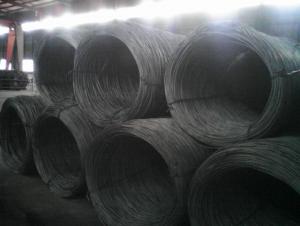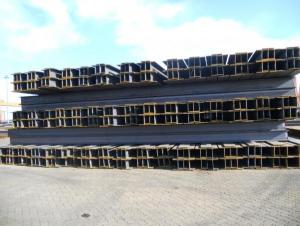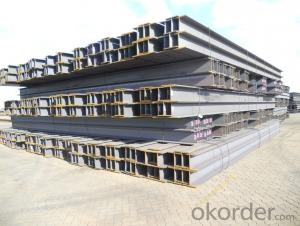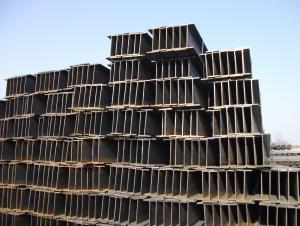H-Beam Structure Steel JIS Standard GB Standard
- Loading Port:
- Tianjin
- Payment Terms:
- TT or LC
- Min Order Qty:
- 50 m.t.
- Supply Capability:
- 40000 m.t./month
OKorder Service Pledge
OKorder Financial Service
You Might Also Like
Product Description:
OKorder is offering H-Beam Structure Steel JIS Standard GB Standardat great prices with worldwide shipping. Our supplier is a world-class manufacturer of steel, with our products utilized the world over. OKorder annually supplies products to European, North American and Asian markets. We provide quotations within 24 hours of receiving an inquiry and guarantee competitive prices.
Product Applications:
H-Beam Structure Steel JIS Standard GB Standard are ideal for structural applications and are widely used in the construction of buildings and bridges, and the manufacturing, petrochemical, and transportation industries.
Product Advantages:
OKorder's H-Beam Structure Steel JIS Standard GB Standard are durable, strong, and resist corrosion.
Main Product Features:
· Premium quality
· Prompt delivery & seaworthy packing (30 days after receiving deposit)
· Corrosion resistance
· Can be recycled and reused
· Mill test certification
· Professional Service
· Competitive pricing
Product Specifications:
Specifications of Hot Rolled Structural Steel H Beam
1. Standard: GB700-88, Q235B2.
2. Grade: Q235, SS400 or Equivalent
3. Length: 6m,10m, 12m as following table
4. Invoicing on theoretical weight or actual weight as customer request
5.Payment: TT or L/C
6. Sizes:
SIZE(mm) | DIMENSION(kg/m) |
100*100 | 16.9 |
125*125 | 23.6 |
150*75 | 14 |
150*150 | 31.1 |
148*100 | 20.7 |
198*99 | 17.8 |
200*100 | 20.9 |
248*124 | 25.1 |
250*125 | 29 |
Usage & Applications of Hot Rolled Structural Steel H Beam
Commercial building structure ;Pre-engineered buildings; Machinery support structure; Prefabricated structure; Medium scale bridges; Ship-building structure. etc.
Packaging & Delivery of Hot Rolled Structural Steel H Beam
1. Packing: it is nude packed in bundles by steel wire rod
2. Bundle weight: not more than 3.5MT for bulk vessel; less than 3 MT for container load
3. Marks:
Color marking: There will be color marking on both end of the bundle for the cargo delivered by bulk vessel. That makes it easily to distinguish at the destination port.
Tag mark: there will be tag mark tied up on the bundles. The information usually including supplier logo and name, product name, made in China, shipping marks and other information request by the customer.
If loading by container the marking is not needed, but we will prepare it as customer request.
4. Transportation: the goods are delivered by truck from mill to loading port, the maximum quantity can be loaded is around 40MTs by each truck. If the order quantity cannot reach the full truck loaded, the transportation cost per ton will be little higher than full load.
5. Delivered by container or bulk vessel
Production flow of Hot Rolled Structural Steel H Beam
Material prepare (billet) —heat up—rough rolling—precision rolling—cooling—packing—storage and transportation
FAQ:
Q1: Why buy Materials & Equipment from OKorder.com?
A1: All products offered byOKorder.com are carefully selected from China's most reliable manufacturing enterprises. Through its ISO certifications, OKorder.com adheres to the highest standards and a commitment to supply chain safety and customer satisfaction.
Q2: How do we guarantee the quality of our products?
A2: We have established an advanced quality management system which conducts strict quality tests at every step, from raw materials to the final product. At the same time, we provide extensive follow-up service assurances as required.
Q3: How soon can we receive the product after purchase?
A3: Within three days of placing an order, we will begin production. The specific shipping date is dependent upon international and government factors, but is typically 7 to 10 workdays.
Images:

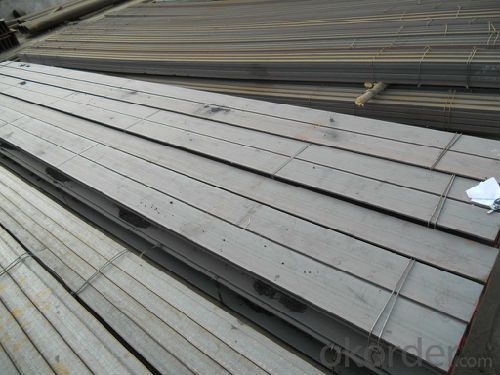
- Q: What are the safety considerations for steel H-beams during installation?
- During the installation of steel H-beams, several safety considerations should be taken into account. Firstly, it is crucial to ensure that the beams are handled and lifted using appropriate equipment, such as cranes or forklifts, by trained and qualified personnel. Secondly, workers should wear appropriate personal protective equipment, including hard hats, safety glasses, and gloves, to prevent injuries from falling objects or sharp edges. Thirdly, it is important to inspect the beams for any defects or damage before installation to avoid structural failures or accidents. Additionally, proper communication and coordination among the installation team are essential to ensure the safe positioning and alignment of the beams. Lastly, following all relevant safety regulations, guidelines, and industry standards is imperative to minimize risks and ensure a safe working environment.
- Q: How do you calculate the plastic section modulus of steel H-beams?
- To determine the plastic section modulus of steel H-beams, it is necessary to go through a series of steps. The plastic section modulus serves as a measure of the beam's resistance to bending and is crucial in establishing its load-carrying capability. Firstly, the geometry of the H-beam must be determined. The plastic section modulus relies on various dimensions, including the width, height, flange thickness, and web thickness of the H-beam. These measurements are typically provided by the manufacturer or can be directly measured. Next, the area of the H-beam must be calculated. This involves subtracting the area of the flanges from the area of the web. The formula for the H-beam's area is as follows: Area = (2 * flange thickness * flange width) + (web thickness * web height). The centroid of the H-beam needs to be calculated as well. The centroid represents the point at which the entire area of the H-beam can be considered to act. The formula for determining the centroid is: Centroid = (A1 * y1 + A2 * y2) / (A1 + A2). In this formula, A1 and A2 refer to the areas of the flanges and web, respectively, while y1 and y2 represent the distances from the centroid of each area to the neutral axis. The moment of inertia, which gauges the H-beam's resistance to bending, must also be calculated. The parallel axis theorem can be used to determine the moment of inertia. The formula for the moment of inertia is as follows: I = (A1 * y1^2) + (A2 * y2^2) + (A1 * (y1 - Centroid)^2) + (A2 * (y2 - Centroid)^2). In this formula, A1, A2, y1, y2, and Centroid are defined as in step 3. Finally, the plastic section modulus can be calculated by dividing the moment of inertia by the distance from the neutral axis to the extreme fiber, which is typically the point of maximum stress. The formula for the plastic section modulus is: Z = I / c. In this formula, Z represents the plastic section modulus, I denotes the moment of inertia, and c signifies the distance from the neutral axis to the extreme fiber. By following these steps and utilizing the appropriate formulas, one can accurately compute the plastic section modulus of steel H-beams. This value is crucial in ascertaining the beam's load-carrying capacity and its ability to withstand bending forces.
- Q: How do steel H-beams perform in earthquakes?
- Steel H-beams perform exceptionally well in earthquakes due to their high strength and ductility. The H-shape design provides superior resistance to lateral forces and bending moments, making them ideal for seismic applications. Their ability to flex and absorb energy during an earthquake helps mitigate damage and ensures structural integrity, making them a reliable choice for earthquake-resistant construction.
- Q: Can steel H-beams be used in curved or sloped structures?
- Yes, steel H-beams can be used in curved or sloped structures. While H-beams are often used in straight structures due to their ability to support heavy loads, they can also be used in curved or sloped structures with proper design considerations. The beams can be bent or curved to fit the desired shape, and their versatility allows for various architectural designs. However, it is important to consult with a structural engineer or an expert in steel construction to ensure that the beams are properly designed, fabricated, and installed to withstand the forces and stresses associated with the curved or sloped structure.
- Q: Can steel H-beams be used in residential pergola or canopy structures?
- Yes, steel H-beams can be used in residential pergola or canopy structures. Steel H-beams are known for their strength and durability, making them suitable for supporting heavy loads and providing structural stability. They can withstand various weather conditions, including wind, rain, and snow, ensuring the longevity and safety of the pergola or canopy structure. Moreover, steel H-beams offer a sleek and modern appearance, adding an aesthetic appeal to the overall design. However, it is essential to consult with a structural engineer or a professional contractor to ensure proper installation and adherence to local building codes and regulations.
- Q: What is the cost of steel H-beams compared to other structural materials?
- The cost of steel H-beams is generally higher compared to other structural materials due to their durability, strength, and versatility. However, their long lifespan and ability to withstand heavy loads make them a cost-effective choice in the long run.
- Q: Can steel H-beams be used for healthcare facilities or hospitals?
- Healthcare facilities or hospitals can indeed utilize steel H-beams. These H-beams are commonly employed in construction due to their robustness, endurance, and capacity to bear heavy loads. In healthcare facilities or hospitals, steel H-beams find application in various ways. They can provide structural support for the building, create partitions or walls, support overhead equipment, and even facilitate the construction of specialized features like surgical theaters or MRI rooms. The adaptability of steel H-beams allows for flexible and efficient design options to cater to the specific requirements of healthcare facilities or hospitals, ensuring the structures' safety and stability. Moreover, steel, being a non-combustible material, adds an extra layer of safety and complies with the stringent fire safety regulations often mandated in healthcare settings. All in all, steel H-beams present a dependable and practical solution for construction in healthcare facilities or hospitals.
- Q: What are the common connections used for steel H-beams?
- The common connections used for steel H-beams are typically achieved through welding or bolting. Welding is a commonly used method, where the ends of the H-beams are aligned and then welded together using a high-intensity heat source. This creates a strong and durable connection between the beams. Bolting is another common method used for connecting steel H-beams. It involves using bolts, nuts, and washers to secure the beams together. Holes are drilled into the flanges and webs of the beams, and then bolts are inserted and tightened to create a secure connection. Both welding and bolting methods have their advantages and disadvantages. Welding provides a seamless connection that can distribute loads more evenly, resulting in better structural integrity. However, welding requires skilled labor and specialized equipment. Bolting, on the other hand, allows for easier disassembly and reassembly, making it more convenient for certain applications. However, it may not offer the same level of load distribution as welding. The choice between welding and bolting connections for steel H-beams depends on various factors such as the specific application, load requirements, ease of installation, and cost considerations. Engineers and structural designers carefully evaluate these factors to determine the most suitable connection method for each project.
- Q: What are the dimensions of a standard steel H-beam?
- The dimensions of a standard steel H-beam may differ based on the individual design and manufacturer. Nevertheless, there are frequently employed dimensions for these beams. Typically, they possess a flange width ranging from 100mm to 900mm, a web height ranging from 100mm to 300mm, and a weight per meter ranging from 17kg to 166kg. It should be emphasized that these dimensions may vary and be subject to specific requirements depending on the intended purpose and load-bearing capacity of the H-beam.
- Q: What are the guidelines for handling and installing steel H-beams?
- To ensure safety and proper installation when handling and installing steel H-beams, it is essential to adhere to several guidelines. These guidelines encompass: 1. Planning and preparation: Prior to commencing the installation process, meticulous planning and site preparation are crucial. This involves determining the appropriate size and type of H-beam required for the project and ensuring the installation site is adequately prepared and leveled. 2. Inspection: Before handling or installing steel H-beams, a thorough inspection must be conducted to ascertain their defect-free condition. Any beams with cracks, bends, or other structural damage should be rejected and substituted. 3. Handling: Given the weight of steel H-beams, it is imperative to employ proper handling techniques to prevent injuries. This entails using suitable lifting equipment, such as cranes or forklifts, and adhering to safe lifting practices. Furthermore, H-beams should be stored in a manner that prevents rolling or falling. 4. Alignment: Ensuring proper alignment of H-beams is crucial during installation. Alignment guides or laser levels can be employed to guarantee that the beams are straight and appropriately positioned. 5. Connection: Bolted connections are typically employed to connect steel H-beams. It is important to adhere to the manufacturer's guidelines regarding the correct size and type of bolts, as well as the recommended torque values. Properly tightening the bolts will establish a secure connection and prevent any movement or shifting of the beams. 6. Welding: In certain cases, welding may be necessary to connect the H-beams. If welding is required, it should be performed by qualified welders who adhere to industry standards and guidelines. Welds should be thoroughly inspected to ensure quality and integrity. 7. Safety precautions: Throughout the entire process of handling and installing steel H-beams, safety should be prioritized. This includes wearing appropriate personal protective equipment (PPE), such as hard hats and safety glasses, and adhering to all safety protocols and regulations. By adhering to these guidelines, the handling and installation of steel H-beams can be carried out safely and effectively, ensuring the structural integrity of the project. It is always recommended to consult professionals or engineers experienced in steel construction for specific guidance and to ensure compliance with local building codes and regulations.
Send your message to us
H-Beam Structure Steel JIS Standard GB Standard
- Loading Port:
- Tianjin
- Payment Terms:
- TT or LC
- Min Order Qty:
- 50 m.t.
- Supply Capability:
- 40000 m.t./month
OKorder Service Pledge
OKorder Financial Service
Similar products
Hot products
Hot Searches
Related keywords



